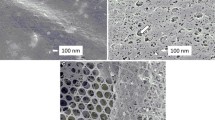Summary
Oil glands ofCitrus deliciosa are multicellular secretory structures, globular to oval in shape, in the centre of which an essential oil-accumulating space is formed. Opening of this space begins from a single cell. It undergoes lysis which later extends to the neighbouring gland cells.
Secretory material in form of droplets is produced in plastids, from where it is transported to the parietal cytoplasm of the secretory cells via numerous ER-elements. After fusion of the ER-membranes with the plasmalemma, the exudate reaches the apoplast, through which it is driven to the central cavity of the gland.
Peripheral cells of the secretory complex are modified into a protective sheath with thick walls and large vacuoles, while their plastids are differentiated from leucoplasts into typical amyloplasts.
Similar content being viewed by others
References
Amelunxen, F., Arbeiter, H., 1967: Untersuchungen an den Spritzdrüsen vonDictamnus albus L. Z. Pflanzenphysiol.58, 49–69.
Biermann, R., 1896: Beiträge zur Kenntnis der Entwicklungs-geschichte der Früchte vonCitrus vulgaris. Diss. Bern.
Bosabalidis, A., Tsekos, I., 1982: Ultrastructural studies on the secretory cavities ofCitrus deliciosa Ten. I. Early stages of the gland cells differentiation. Protoplasma112, 55–62.
Brandt, W., 1924: Zur Anatomie und Chemie derRuta graveolens. Arch. Pharm.262, 160.
Cockburn, B. J., Wellburn, A. R., 1974: Changes in the envelope permeability of developing chloroplasts. J. exp. Bot.25, 36–49.
Esau, K., 1972: Changes in the nucleus and the endoplasmic reticulum during differentiation of a sieve element inMimosa pudica L. Ann. Bot.36, 703–710.
Fahn, A., 1979: Secretory tissues in plants. New York-San Francisco-London: Academic Press.
Fohn, M., 1935: Zur Entstehung und Weiterbildung der Exkreträume vonCitrus medica L. undEucalyptus globulus Lab. Österr. bot. Z.84, 198–209.
Gebicki, J. M., Hicks, M., 1973: Ufasomes are stable particles surrounded by unsaturated fatty acid membranes. Nature243, 232–234.
Hampp, R., Schmidt, H. W., 1976: Changes in envelope permeability during chloroplast development. Planta129, 69–73.
Heinrich, G., 1966: Licht- und Elektronenmikroskopische Untersuchungen zur Genese der Exkrete in den lysigenen Exkreträumen vonCitrus medica. Flora156, 451–456.
—, 1969: Elektronenmikroskopische Beobachtungen zur Ent-stehungsweise der Exkretbehälter vonRuta graveolens, Citrus limon undPoncirus trifoliata. Österr. bot. Z.117, 397–403.
—, 1970: Elektronenmikroskopische Beobachtungen an den Drüsen-zellen vonPoncirus trifoliata; zugleich ein Beitrag zur Wirkung ätherischer Öle auf Pflanzenzellen und eine Methode zur Unterscheidung flüchtiger von nicht-flüchtigen lipophilen Komponenten. Protoplasma69, 15–36.
—, 1973: Die Feinstruktur der Trichom-Hydathoden vonMonarda fistulosa. Protoplasma77, 271–278.
Lombardo, G., Bassi, M., Gerola, F. M., 1970: Mycoplasma development and cell alterations in white clover affected by cloverdwarf. An electron microscopy study. Protoplasma70, 61–71.
Martinet, M., 1871: Organes de sécrét. d. végétaux. Ann. d. sc. nat. Sér. VI. T. XIV.
Mogensen, H. L., 1978: Pollen tube-synergid interactions inProboscidea lousianica (Martineaceae). Amer. J. Bot.65, 953–964.
Nagl, W., 1976: Ultrastructural and developmental aspects of autolysis in embryo-suspensors. Ber. dtsch. bot. Ges.89, 301–311.
Norstog, K., 1974: Nucellus during early embryogeny in barley: fine structure. Bot. Gaz.135, 97–103.
Peterson, R. L., Scott, M. G., Ellis, B. E., 1978: Structure of a stem-derived callus ofRuta graveolens: meristems, leaves and secretory structures. Can. J. Bot.56, 2717–2729.
Pilar, G., Landmesser, L., 1976: Ultrastructural differences during embryonic cell death in normal and peripherally deprived ciliary ganglia. J. Cell Biol.68, 339–356.
Platt-Aloia, K. A., Thomson, W. W., 1976: An ultrastructural study of two forms of chilling-induced injury to the rind of grapefruit (Citrus parodist Macfed.). Cryobiology13, 95–106.
Ragetli, H. W. J., Weintraub, M., Lo, E., 1970: Degeneration of leaf cells resulting from starvation after excision. I. Electron microscopic observations. Can. J. Bot.48, 1913–1922.
Schnepf, E., 1969: Sekretion und Exkretion bei Pflanzen. Protoplasmatologia8. Wien-New York: Springer.
—,Busch, J., 1976: Morphology and kinetics of slime secretion in glands ofMimulus tilingii. Z. Pflanzenphysiol.79, 62–71.
—,Benner, U., 1978: Die Morphologie der Nektarausscheidung bei Bromeliaceen. II. Experimentelle und quantitative Untersuchungen beiBillbergia nutans. Biochem. Physiol. Pflanzen173, 23–36.
Sieck, W., 1895: Die schizolysigenen Sekretbehälter. Jb. wiss. Bot.27, 197–242.
Sprecher, E., 1956: Beiträge zur Frage der Biogenese sekundärer Pflanzenstoffe der Weinraute (Ruta graveolens L.). Planta47, 323–358.
Tan, T., Ueda, K., 1978: Rapid degeneration of the protoplasm in artificially induced small cells ofMicrasterias crux melitensis. Protoplasma97, 61–70.
Thomson, W. W., Platt-Aloia, K., Endress, A. G., 1976: Ultrastructure of oil gland development in the leaf ofCitrus sinensis. L. Bot. Gaz.137, 330–340.
Vijayraghavan, M. R., Jensen, W. A., Ashton, M. E., 1972: Synergids ofAquilegia formosa. Their histochemistry and ultrastructure. Phytomorphology22, 144–159.
Withers, L. A., 1978: A fine structural study of the freeze-preservation of plant tissue cultures. II. The thawed state. Protoplasma94, 235–247.
Author information
Authors and Affiliations
Rights and permissions
About this article
Cite this article
Bosabalidis, A., Tsekos, I. Ultrastructural studies on the secretory cavities ofCitrus deliciosa ten. II. Development of the essential oil-accumulating central space of the gland and process of active secretion. Protoplasma 112, 63–70 (1982). https://doi.org/10.1007/BF01280216
Received:
Accepted:
Issue Date:
DOI: https://doi.org/10.1007/BF01280216




